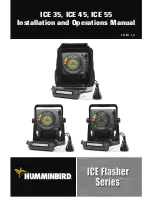
1
HOW SONAR WORKS
Sonar technology is based on sound waves. The ICE Flasher Series™ Fishfinder uses
sonar to locate structure, bottom composition, as well as depth directly below the
transducer. Your ICE Flasher Series™ Fishfinder consists of two components: the control
head and the transducer. The control head contains the transmitter and receiver, as well
as the user controls and display. The transducer is suspended beneath the water,
underneath the ice, and converts electrical energy from the transmitter into mechanical
pulses or sound waves. The transducer also receives the reflected sound waves and
converts them back into electrical signals for display on the Flasher Dial.
NOTE:
The transducer must be submerged in water for reliable transducer detection. The
bottom of the transducer should be even with the bottom of the ice or hang slightly below
the bottom of the ice.
Your ICE Flasher Series™ Fishfinder sends a sound wave signal and determines distance
by measuring the time between the transmission of the sound wave and when the
sound wave is reflected off of an object; it then uses the reflected signal to interpret
depth, size, and composition of an object.
Sonar is very fast. A sound wave can travel from the surface to a depth of 240 ft (70 m)
and back again in less than 1/4 of a second.
SONAR is an acronym for SOund and
NAvigation Ranging. Sonar utilizes precision
sound pulses or “pings” which are emitted
into the water in a teardrop-shaped beam.
The sound pulses “echo” back from objects
in the water such as the bottom, fish and
other submerged objects. The returned
echoes, or signals, are displayed as colored
lines on the Flasher Dial.
Real Time Sonar
Instant Display





















